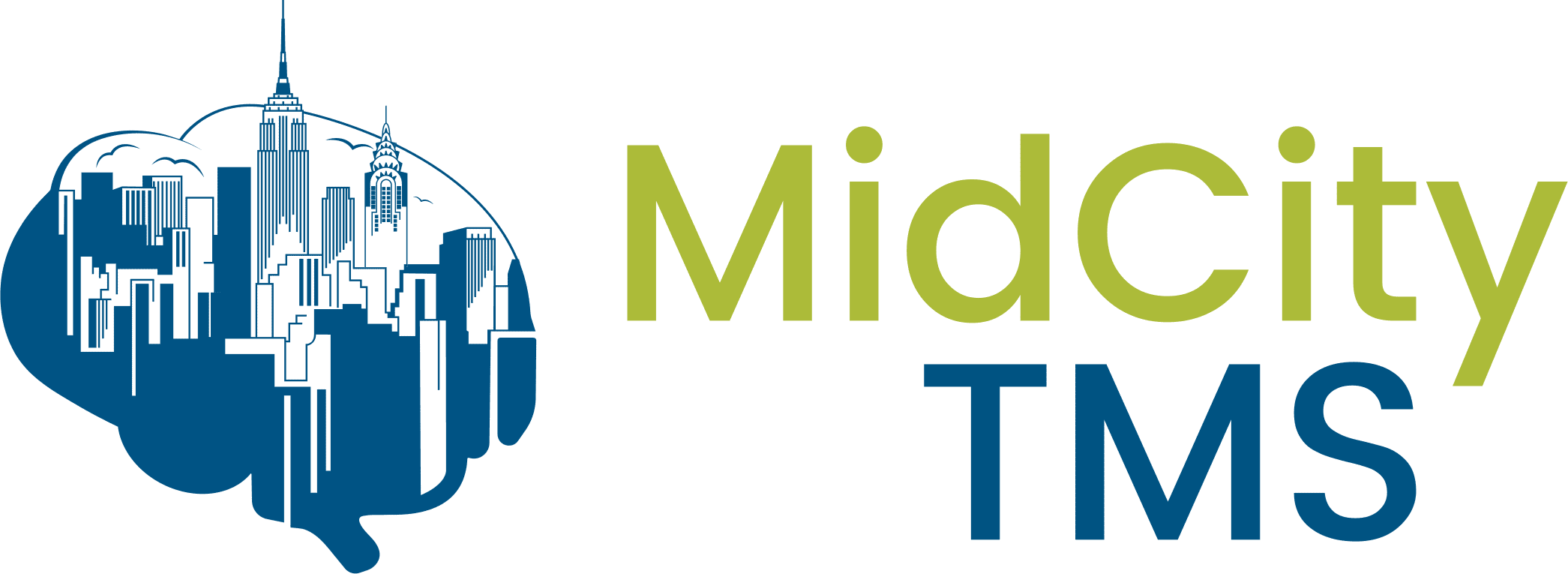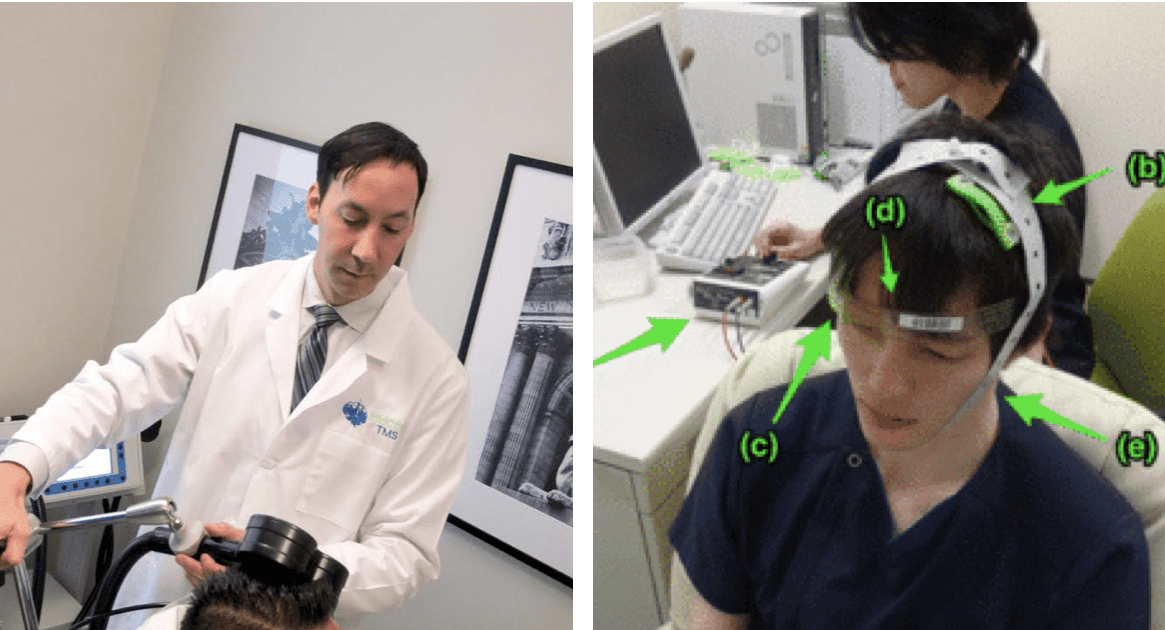Patients often feel trapped when their depression doesn’t respond to traditional methods of treatment such as pharmacology and therapy. Depression is a treatable disease. Traditional methods are not your only option. Nonsurgical brain stimulation methods are continually gaining attention as effective strategies for treating depression. As the field’s recognition broadens, new methodologies have emerged. rTMS (repetitive Transcranial Magnetic Stimulation) is an established and trusted form of nonsurgical brain stimulation; tDCS (Transcranial Direct Current Stimulation) is another brain stimulation method. Mid City TMS wants to help our patients understand the difference between rTMS and tDCS by explaining how the treatments are conducted, their safety, and their effectiveness. The term “TMS” is often used interchangeably
with “rTMS”, though “rTMS” (what is usually used in clinical practice) refers specifically to repetitive delivery of TMS as opposed to single-pulse TMS (often used in research settings to explore brain functioning).
How rTMS Works
rTMS employs the magnetic field to stimulate the brain’s nerves. To accomplish this, a pulsing electromagnetic coil is placed near a patient’s head. The patient rests in a specialized chair.
The patient doesn’t require an anesthetic for this procedure, which lasts 20-45 minutes.
On average, candidates for rTMS will schedule 5 TMS sessions per week lasting between 4-7 weeks.
Between 50 to 70 percent of patients with previously unresponsive depression find substantial relief with rTMS. For an in-depth explanation of how rTMS works, click here.
Side Effects
It is uncommon for patients to experience side effects and rare for patients to end their rTMS treatment due to side effects. Side effects can include:
- Facial twitching or uncomfortable scalp sensations accompanying the rTMS coil’s pulsations
- Mild headaches, which usually resolve after the first week
- Seizures are the most serious potential side effect, but they are extremely rare and almost always avoidable with proper screening.
How tDCS Works
tDCS utilizes low levels of electric current to stimulate the brain. Small, battery-powered electrodes are placed on the head and secured with an elastic strap. The tDCS devices are connected to a stimulator that sends currents through the electrodes and into the patient’s brain.
No anesthetics are required for a patient to undergo tDCS. Sessions typically last between 20-30 minutes. Daily stimulation can lead to accumulated excitability effects. Standardizations outlining treatment frequency are not yet in place. There is limited data quantifying how long it takes tDCS treatments to wear off and require administration.
Patients should receive their tDCS treatment at the same time of day to lower the risks of disrupting their sleep-wake cycle.
Side Effects
The side effects of tDCS are usually short-lived and mild. The documented side effects include:
- Itching
- Tingling
- Headache
- Burning sensations
Skin reddening around the site of the tDCS device can occur due to the increased flow of dermal vessels. The reddening fades and is not painful to the touch.
The Difference Between rTMS and tDCS FDA Approvals
rTMS
rTMS is the most commonly practiced brain stimulation method. It received FDA approval in 2008 and is an indicated treatment option for patients with treatment-resistant depression.
In addition to its acceptance in the United States, rTMS has gained approval and widespread use in Canada, Australia, New Zealand, the European Union, and Israel.
tDCS
The FDA hasn’t issued an opinion on tDCS. In the United States, tDCS is under the “investigational” regulatory status. A study published in the US National Library of Medicine cites tDCS as a complex and currently poorly understood means of stimulating neural tissue. It cautions clinicians to have current, scientific knowledge of this developing treatment method in order to ethically practice or prescribe tDCS.
rTMS vs tDCS Effectiveness
As the mainstream medical community has realized the effectiveness of nonsurgical brain stimulation for treating depression, studies have been conducted to determine which methodology is most effective. A study published on The BMJin March of this year compared the effectiveness of the established rTMS treatment method to the tDCS approach. After observing the results of 6,750 people in 113 clinical trials and comparing their findings to a control group, the researchers’ data revealed rTMS as the most effective treatment option.
Unlike, rTMS, there is little data to support tDCS’ ability to achieve positive response and remission rates. For example, a 2013 study employed both active and sham tDCS treatments, and it discovered no notable differences in each test groups’ response and remission rates. Alternately, rTMS has an established history of demonstrating effective response and remission rates in patients with treatment-resistant depression. A study published in The American Journal of Psychiatry tracked the clinical trial conducted the year prior where patients with treatment-resistant depression were given TMS treatments. The data revealed that 50% of the patients experienced fewer symptoms after receiving TMS, and one-third experienced complete remission in response to their TMS treatment.
The primary difference between rTMS and tDCS is the years of research, clinical trials, and positive patient outcomes backing rTMS, as compared to the limited information and resources for effectively administering tDCS. On PubMed.gov alone, there are 16,498 studies involving rTMS, and only 4,915 studies analyzing tDCS.
Mid City TMS Provides the Most Effective Stimulation Treatment Method
At Mid City TMS, we are excited to see the body of research surrounding nonsurgical brain stimulation methodologies expand, reinforcing rTMS’ safety and effectiveness. While emerging stimulation methodologies are intriguing, rTMS’ years of application and research have made it the most trusted and successful nonconvulsive and noninvasive brain stimulation treatment method.
If you’re suffering from non-responsive depression, reach out to our office. Our team will help you form a treatment plan. We provide relief for the crippling symptoms of depression.



